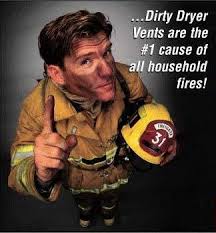Fire Hazard of Dirty Dryer Vents
 These topical reports are designed to explore facets of the U.S. fire problem as depicted through data collected in the U.S. Fire Administration's (USFA's) National Fire Incident Reporting System (NFIRS). Each topical report briefly addresses the nature of the specific fire or fire-related topic, highlights important findings from the data, and may suggest other resources to consider for further information. Also included are recent examples of fire incidents that demonstrate some of the issues addressed in the report or that put the report topic in context.
These topical reports are designed to explore facets of the U.S. fire problem as depicted through data collected in the U.S. Fire Administration's (USFA's) National Fire Incident Reporting System (NFIRS). Each topical report briefly addresses the nature of the specific fire or fire-related topic, highlights important findings from the data, and may suggest other resources to consider for further information. Also included are recent examples of fire incidents that demonstrate some of the issues addressed in the report or that put the report topic in context.
Findings
- An estimated 2,900 clothes dryer fires in residential buildings are reported to U.S. fire departments each year and cause an estimated 5 deaths, 100 injuries, and $35 million in property loss.
- Clothes dryer fire incidence in residential buildings was higher in the fall and winter months, peaking in January at 11 percent.
- Failure to clean (34 percent) was the leading factor contributing to the ignition of clothes dryer fires in residential buildings.
- Dust, fiber, and lint (28 percent) and clothing not on a person (27 percent) were, by far, the leading items first ignited in clothes dryer fires in residential buildings.
- Fifty-four percent of clothes dryer fires in residential buildings were confined to the object of origin.
For many households and other establishments, the clothes dryer is an indispensable convenience and necessity. However, damaging fires can occur if clothes dryers are not properly installed and maintained. Eighty four percent of clothes dryer fires that occurred in buildings took place in residential buildings. Because the residential building portion of these fires predominates, the primary focus of this analysis addresses the characteristics of clothes dryer fires in residential buildings reported to the National Fire Incident Reporting System (NFIRS). The focus is on fires reported from 2008 to 2010, the most recent data available at the time of this analysis.
From 2008 to 2010, fire departments responded to an estimated 2,900 clothes dryer fires in residential buildings each year across the Nation. These fires resulted in an annual average loss of 5 deaths, 100 injuries, and $35 million in property loss.
For the purpose of this report, the term "clothes dryer fires" is synonymous with "clothes dryer fires in residential buildings." "Clothes dryer fires" is used throughout the body of this report; the findings, tables, charts, headings, and footnotes reflect the full category, "clothes dryer fires in residential buildings."
The Hows and Whys of a Clothes Dryer Fire
A clothes dryer works by forcing hot air through a turning drum. Wet clothes placed in the drum are then dried by moving hot air. It is possible for a full load of wet clothes to contain as much as one and a half gallons of water. Lint, consisting mostly of small fibers from the clothes and debris in or on the clothes, is created from the clothes as the clothes tumble in the drum. While much of the lint is trapped by the dryer's filter, lint is also carried through the vent system along with moist air. Lint is a highly combustible material that can accumulate both in the dryer and in the dryer vent. Accumulated lint leads to reduced airflow and can pose a potential fire hazard.
In addition to the accumulation of lint, blockage in dryer exhaust vents also can occur from the nests of small birds or other animals or from damages to the venting system itself. A compromised vent will not exhaust properly to the outside. As a result, overheating may occur and a fire may ensue.
Loss Measures
Table 1 presents losses, averaged over the 3-year period from 2008 to 2010, of reported clothes dryer fires in residential buildings. The average number of injuries per 1,000 clothes dryer fires was slightly higher than the same loss measure for all other residential building fires. The average number of fatalities per 1,000 clothes dryer fires and average dollar loss per clothes dryer fire, however, were notably less than the same loss measures for all other residential building fires.

Where Clothes Dryer Fires in Residential Buildings Occur
One- and two-family residences accounted for 77 percent of clothes dryer fires as shown in Table 2. Only 17 percent of clothes dryer fires occurred in multifamily dwellings, and even fewer occurred in hotels and motels (3 percent). The remaining 3 percent of clothes dryer fires occurred in other residential buildings including boarding and rooming homes, sororities and fraternities, dormitories, barracks, and other residences.

In addition, as expected, clothes dryer fires most often started in laundry areas (83 percent) as shown in Table 3. The next leading areas of origin for clothes dryer fires were substructure areas such as crawl spaces and garages (each at 3 percent), kitchens (2 percent), and other service or equipment areas (1 percent).

As shown in Figure 1, clothes dryer fires increased in frequency beginning in the early morning and occurred fairly regularly between the hours of 8 a.m. and midnight, with a slight peak between 1 and 2 p.m. (7 percent).Clothes dryer fires then declined reaching the lowest point between 3 and 6 a.m., when most people are expected to be sleeping.When Clothes Dryer Fires in Residential Buildings Occur

Figure 2 illustrates that clothes dryer fire incidence was higher in the fall and winter months, peaking at 11 percent in January. The increase in fires in the cooler months may be explained by the quantity and type of clothes worn in these months. In addition, people are less likely to dry clothes outdoors during the cooler months than during the warmer months.

Factors Contributing to Ignition in Clothes Dryer Fires in Residential Buildings
Table 4 shows the categories of factors contributing to ignition in clothes dryer fires. The leading category was "operational deficiency" (47 percent). The leading specific factor contributing to ignition, which is part of the operational deficiency category, was failure to clean. This is not surprising as proper clothes dryer maintenance to avoid a fire hazard involves removing the lint from the traps, vents, and surrounding areas of the dryer. Failure to clean accounted for 72 percent of the operational deficiency contributing factors category. It also accounted for 34 percent of all clothes dryer fires in residential buildings.
The second leading factors contributing to ignition category was "mechanical failure, malfunction" at 29 percent. "Electrical failure, malfunction" was the third leading category at 16 percent. Reduced airflow resulting from lint buildup in the screen or other areas around the dryer can cause a clothes dryer to not operate efficiently and possibly overheat. Problems can also occur if improper items, such as foam-backed rugs or athletic shoes, are placed in dryers, or plastic or vinyl exhaust materials are used to vent the appliances.

What Ignites First in Clothes Dryer Fires in Residential Buildings
Not unexpectedly, dust, fiber, and lint (28 percent) and clothing not on a person (27 percent) were, by far, the leading items first ignited as shown in Table 5. Other leading items first ignited included other soft goods, wearing apparel or clothing (9 percent), appliance housing or casing (8 percent), linen other than bedding (6 percent), and electrical wire, cable insulation (also 6 percent).

